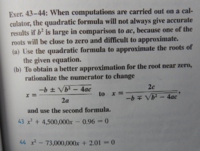allegansveritatem
Full Member
- Joined
- Jan 10, 2018
- Messages
- 962
I have been all over the internet looking for info on this subject and found nothing. A couple of sites mentioned it but the explanations were sketchy and/or downright obscure. Here is the problem:
When computations are carried out on a calculator, the Quadratic Formula will not always give accurate results if b2 is large in comparison to ac, because one of the roots will be close to zero and difficult to approximate.
(a) Use the Quadratic Formula to approximate the roots of the given equations.
(b) To obtain a better approximation for the root near zero, rationalize the numerator to change
. . . . .[math]x\, =\, \dfrac{-b\, \pm\, \sqrt{b^2\, -\, 4ac\,}}{2a}\, \mbox{ to }\, x\, =\, \dfrac{2c}{-b\, \mp\, \sqrt{b^2\, -\, 4ac\,}}[/math]
43.x2+4,500,000x−0.96=0
44.x2−73,000,000x+2.01=0
What I want to know here is not how to calculate the figures, but how did they derive that alternate form of the equation. The excellent solutions manual I have goes through the whole process of derivation but does not go into enough detail to make it clear. What is exercising my curiosity to the max is: How to multiply the conjugate of a term containing+/- with its conjugate and what does it mean when you flip the sign to -/+. Here is what the solutions manual has to say:

so, I guess my question is this: Why flip the sign and what does that effect? And my other question has to do with the words:"The root near zero was obtained in part (a) using the plus sign. In the second formula it corresponds to the minus sign." Say what???
When computations are carried out on a calculator, the Quadratic Formula will not always give accurate results if b2 is large in comparison to ac, because one of the roots will be close to zero and difficult to approximate.
(a) Use the Quadratic Formula to approximate the roots of the given equations.
(b) To obtain a better approximation for the root near zero, rationalize the numerator to change
. . . . .[math]x\, =\, \dfrac{-b\, \pm\, \sqrt{b^2\, -\, 4ac\,}}{2a}\, \mbox{ to }\, x\, =\, \dfrac{2c}{-b\, \mp\, \sqrt{b^2\, -\, 4ac\,}}[/math]
43.x2+4,500,000x−0.96=0
44.x2−73,000,000x+2.01=0
What I want to know here is not how to calculate the figures, but how did they derive that alternate form of the equation. The excellent solutions manual I have goes through the whole process of derivation but does not go into enough detail to make it clear. What is exercising my curiosity to the max is: How to multiply the conjugate of a term containing+/- with its conjugate and what does it mean when you flip the sign to -/+. Here is what the solutions manual has to say:

so, I guess my question is this: Why flip the sign and what does that effect? And my other question has to do with the words:"The root near zero was obtained in part (a) using the plus sign. In the second formula it corresponds to the minus sign." Say what???
Attachments
Last edited by a moderator:


